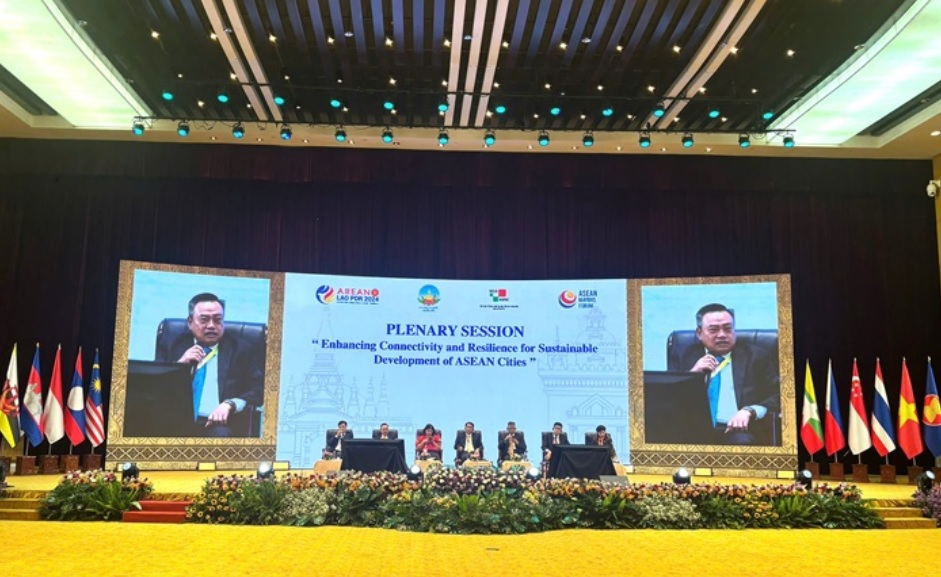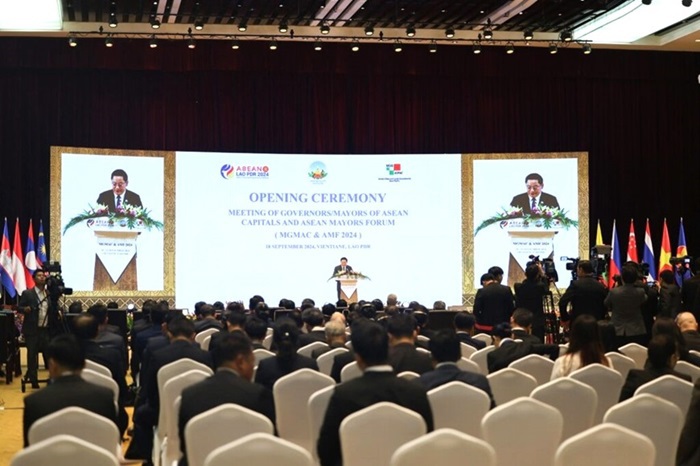HANOI FOREIGN RELATION ACTIVITIES

Hanoi has concentrated resources on building a "New Rural Development" program, prioritizing infrastructure development for agriculture and rural areas, especially in transportation and irrigation systems.
Chairman of the Hanoi People’s Committee Tran Sy Thanh stated that over the past 10 years, the city has focused its resources on building a "New Rural Development" program, with a priority on developing infrastructure for agriculture and rural areas.

Chairman of the Hanoi People's Committee Tran Sy Thanh at the event.
On September 18, at the plenary session of the Meeting of ASEAN Capital Mayors (MGMAC) and the ASEAN Mayors Forum (AMF) held in Vientiane, Laos, on behalf of Hanoi, Chairman of the Hanoi People’s Committee Tran Sy Thanh delivered a presentation on "Some experiences in narrowing the gap in living conditions between urban and rural areas."
At the conference, Chairman Tran Sy Thanh affirmed that the development of agriculture, rural areas, and farmers has always been a priority for the Party and Government of Vietnam. Reducing the gap between urban and rural areas has been identified as one of the strategic tasks to achieve comprehensive and sustainable development.
Following the administrative boundary expansion in 2008, Hanoi now covers over 3,300 km² with 30 administrative units (12 districts, 17 rural districts, and 1 town). At that time, the city's agricultural area was relatively large compared to other capitals worldwide (about 200,000 hectares, accounting for 59% of the total area), with over 4.2 million rural residents making up more than 50% of the total population. The rural labor force comprised about 2.3 million people, accounting for over 56% of the city's total workforce. Rural areas were identified as economically disadvantaged with poor infrastructure, particularly in agriculture, where production remained small-scale and fragmented.
Over the past 10 years, following government directives, Hanoi has concentrated resources on building a "New Rural Development" program, prioritizing infrastructure development for agriculture and rural areas, especially in transportation and irrigation systems. Industrial zones, specialized production areas, and renowned craft villages have been developed in a relatively coordinated manner. High-quality OCOP (One Commune, One Product) products have gradually conquered demanding markets like Europe and the US, leading to daily improvements in the economic and cultural lives of rural residents.

Overview of the meeting.
Five lessons
Chairman Tran Sy Thanh shared several lessons from these achievements with the conference attendees:
Firstly, focus on developing integrated infrastructure and regional connectivity. The city has invested significantly in transportation infrastructure, particularly road systems and connections between urban and rural areas. Land allocated for transportation now exceeds 10%, with plans to reach 12-15% by 2025. Along with agricultural production infrastructure, irrigation systems, and industrial zones, this has contributed to improved trade, logistics services, and market access for rural residents.
Secondly, promote rural economic development aligned with green transition and circular economy principles. Hanoi has implemented new economic models, promoting high-tech agriculture and expanding OCOP (currently with nearly 2,000 products). Circular economy initiatives are encouraged, creating jobs and income for farmers while protecting the environment and maintaining ecological balance, contributing to sustainable development. The average per capita income in rural Hanoi is now around USD 3,000.
Thirdly, invest in healthcare, education, and cultural systems in rural areas. The aim is to ensure equal access to comprehensive education and training for rural residents, helping to improve farmers' skills and enhance their productivity and competitiveness. The city emphasizes career-oriented education, integrating STEM subjects to meet the demands of the Fourth Industrial Revolution.
Fourthly, leverage digital technology to bridge the urban-rural divide. Hanoi has accelerated digital transformation in management, operations, and public service delivery in rural areas, enabling easier access to information, administrative, healthcare, and educational services. This has also created opportunities for rural digital economic development and entrepreneurship. Today, there is little difference between urban and rural areas in terms of access to the internet and digital technologies, with 80% of households owning at least one smartphone, and all villages having mobile or broadband internet coverage.
Fifthly, prioritize social welfare, ensuring quality of life for all residents. The city has focused on improving healthcare services and applying technology in medical care and disease prevention. Social welfare programs receive significant attention, with over 7.8 million people (95%) enrolled in health insurance. Annual support reaches 99.9% of children with special needs, and there are no longer any households classified as poor according to national standards.
Key solutions
Chairman Tran Sy Thanh emphasized Hanoi's vision to become a "Cultural, Civilized, Modern, Green, Smart, and Globally Connected City" with high competitiveness. To achieve this, Hanoi is focused on building an "Ecological Agriculture, Modern Rural Areas, and Cultured Farmers" strategy with key priorities:
Firstly, enhance the role, position, and autonomy of farmers and rural residents, improving their material and spiritual lives. Focus on renewing and improving training, communication, and awareness to empower farmers, ensuring their rights under the motto "The people know, discuss, act, check, supervise, and benefit."
Secondly, develop sustainable agriculture with an ecological approach, applying advanced science and technology. Restructure the agricultural sector to be more effective, tapping into the advantages of tropical agriculture, and closely linking agriculture with industry and services.
Thirdly, promote ecological agriculture along the Red and Day rivers, focusing on organic farming with clean, high-quality products. Priority is given to circular farming models that protect the environment, ensure disease safety, and develop closed-loop livestock production.
Fourthly, build a comprehensive and sustainable New Rural Development program linked with urbanization, ensuring real benefits for residents. Local planning and housing construction must align with local cultural traditions, environmental conditions, and climate change adaptation.
Fifthly, manage and use resources efficiently, transitioning to a green growth model. Utilize natural water bodies and convert low-lying land into aquaculture, protecting natural aquatic resources in areas like the Da and Red rivers, while exploiting ecological and climatic potential for tourism development.
Finally, to sustainably bridge the urban-rural divide, Hanoi encourages the active and proactive participation of rural communities in local development, with the principle that "Rural residents are the key actors and center of agricultural, rural economic development, and new rural area construction."
Ngoc Mai